Physiological and Perceptual Responses to Nordic Walking in a Natural Mountain Environment
Abstract
1. Introduction
2. Materials and Methods
2.1. Participant Characteristics
2.2. Research Design
2.3. Measurement Energy Expenditure and Locomotion Parameters
2.4. Determination of Rating of Perceived Exertion (RPE)
2.5. Statistical Analysis
3. Results
3.1. Energy Ependiture of Locomotion
3.2. Heart Rate
3.3. Locomotion Dynamics
3.4. Rating of Perceived Exertion
4. Discussion
5. Conclusions
Author Contributions
Conflicts of Interest
References
- Wanner, M.; Martin-Diener, E.; Bauer, G.F.; Stamm, H.; Martin, B.W. Allez hop, a nationwide programme for the promotion of physical activity in switzerland: What is the evidence for a population impact after one decade of implementation? Br. J. Sports Med. 2011, 45, 1202–1207. [Google Scholar] [CrossRef] [PubMed]
- Mathieson, S.; Lin, C.W. Health benefits of nordic walking: A systematic review. Br. J. Sports Med. 2014, 48, 1577–1578. [Google Scholar] [CrossRef] [PubMed]
- Schiffer, T.; Knicker, A.; Hoffman, U.; Harwig, B.; Hollmann, W.; Struder, H.K. Physiological responses to nordic walking, walking and jogging. Eur. J. Appl. Physiol. 2006, 98, 56–61. [Google Scholar] [CrossRef] [PubMed]
- Shim, J.M.; Kwon, H.Y.; Kim, H.R.; Kim, B.I.; Jung, J.H. Comparison of the effects of walking with and without nordic pole on upper extremity and lower extremity muscle activation. J. Phys. Ther. Sci. 2013, 25, 1553–1556. [Google Scholar] [CrossRef] [PubMed]
- Figard-Fabre, H.; Fabre, N.; Leonardi, A.; Schena, F. Physiological and perceptual responses to nordic walking in obese middle-aged women in comparison with the normal walk. Eur. J. Appl. Physiol. 2010, 108, 1141–1151. [Google Scholar] [CrossRef] [PubMed]
- Rodgers, C.D.; VanHeest, J.L.; Schachter, C.L. Energy expenditure during submaximal walking with exerstriders. Med. Sci. Sports Exerc. 1995, 27, 607–611. [Google Scholar] [CrossRef] [PubMed]
- Hansen, E.A.; Smith, G. Energy expenditure and comfort during nordic walking with different pole lengths. J. Strength Cond. Res. 2009, 23, 1187–1194. [Google Scholar] [CrossRef] [PubMed]
- Stief, F.; Kleindienst, F.I.; Wiemeyer, J.; Wedel, F.; Campe, S.; Krabbe, B. Inverse dynamic analysis of the lower extremities during nordic walking, walking, and running. J. Appl. Biomech. 2008, 24, 351–359. [Google Scholar] [CrossRef] [PubMed]
- Hartvigsen, J.; Morso, L.; Bendix, T.; Manniche, C. Supervised and non-supervised nordic walking in the treatment of chronic low back pain: A single blind randomized clinical trial. BMC Musculoskelet Disord. 2010, 11, 30. [Google Scholar] [CrossRef] [PubMed]
- Wendlova, J. Nordic walking—Is it suitable for patients with fractured vertebra? Bratisl. Lek. Listy 2008, 109, 171–176. [Google Scholar] [PubMed]
- Kocur, P.; Deskur-Smielecka, E.; Wilk, M.; Dylewicz, P. Effects of nordic walking training on exercise capacity and fitness in men participating in early, short-term inpatient cardiac rehabilitation after an acute coronary syndrome—A controlled trial. Clin. Rehabil. 2009, 23, 995–1004. [Google Scholar] [CrossRef] [PubMed]
- Fischer, M.J.; Krol-Warmerdam, E.M.; Ranke, G.M.; Vermeulen, H.M.; Van der Heijden, J.; Nortier, J.W.; Kaptein, A.A. Stick together: A nordic walking group intervention for breast cancer survivors. J. Psychosoc. Oncol. 2015, 33, 278–296. [Google Scholar] [CrossRef] [PubMed]
- Bulinska, K.; Kropielnicka, K.; Jasinski, T.; Wojcieszczyk-Latos, J.; Pilch, U.; Dabrowska, G.; Skorkowska-Telichowska, K.; Kalka, D.; Zywar, K.; Paszkowski, R.; et al. Nordic pole walking improves walking capacity in patients with intermittent claudication: A randomized controlled trial. Disabil. Rehabil. 2016, 38, 1318–1324. [Google Scholar] [CrossRef] [PubMed]
- Van Eijkeren, F.J.; Reijmers, R.S.; Kleinveld, M.J.; Minten, A.; Bruggen, J.P.; Bloem, B.R. Nordic walking improves mobility in parkinson’s disease. Mov. Disord. 2008, 23, 2239–2243. [Google Scholar] [CrossRef] [PubMed]
- Porcari, J.P.; Hendrickson, T.L.; Walter, P.R.; Terry, L.; Walsko, G. The physiological responses to walking with and without power poles on treadmill exercise. Res. Q. Exerc. Sport 1997, 68, 161–166. [Google Scholar] [CrossRef] [PubMed]
- Church, T.S.; Earnest, C.P.; Morss, G.M. Field testing of physiological responses associated with nordic walking. Res. Q. Exerc. Sport 2002, 73, 296–300. [Google Scholar] [CrossRef] [PubMed]
- Rybicki, J.R.; Leszczynska-Bolewska, B.M.; Grochulska, W.E.; Malina, T.F.; Jaros, A.J.; Samek, K.D.; Baner, A.A.; Kapko, W.S. Oxygen uptake during nordic walking training in patients rehabilitated after coronary events. Kardiol. Pol. 2015, 73, 17–23. [Google Scholar] [CrossRef] [PubMed]
- Sugiyama, K.; Kawamura, M.; Tomita, H.; Katamoto, S. Oxygen uptake, heart rate, perceived exertion, and integrated electromyogram of the lower and upper extremities during level and nordic walking on a treadmill. J. Physiol. Anthropol. 2013, 32, 2. [Google Scholar] [CrossRef] [PubMed]
- Kruisdijk, F.R.; Hendriksen, I.J.; Tak, E.C.; Beekman, A.T.; Hopman-Rock, M. Effect of running therapy on depression (EFFORT-D). Design of a randomised controlled trial in adult patients [ISRCTN 1894]. BMC Public Health 2012, 12, 50. [Google Scholar] [CrossRef] [PubMed]
- Bovi, G.; Rabuffetti, M.; Mazzoleni, P.; Ferrarin, M. A multiple-task gait analysis approach: Kinematic, kinetic and EMG reference data for healthy young and adult subjects. Gait Posture 2011, 33, 6–13. [Google Scholar] [CrossRef] [PubMed]
- Townshend, A.D.; Worringham, C.J.; Stewart, I.B. Spontaneous pacing during overground hill running. Med. Sci. Sports Exerc. 2010, 42, 160–169. [Google Scholar] [CrossRef] [PubMed]
- Koehler, K.; Braun, H.; de Marees, M.; Fusch, G.; Fusch, C.; Schaenzer, W. Assessing energy expenditure in male endurance athletes: Validity of the sensewear armband. Med. Sci. Sports Exerc. 2011, 43, 1328–1333. [Google Scholar] [CrossRef] [PubMed]
- Santos-Lozano, A.; Hernández-Vicente, A.; Pérez-Isaac, R.; Santín-Medeiros, F.; Cristi-Montero, C.; Casajús, J.A.; Garatachea, N. Is the SenseWear Armband accurate enough to quantify and estimate energy expenditure in healthy adults? Ann. Transl. Med. 2017, 5, 97. [Google Scholar] [CrossRef] [PubMed]
- Borg, G.A. Psychophysical bases of perceived exertion. Med. Sci. Sports Exerc. 1982, 14, 377–381. [Google Scholar] [CrossRef] [PubMed]
- Perrey, S.; Fabre, N. Exertion during uphill, level and downhill walking with and without hiking poles. J. Sports Sci. Med. 2008, 7, 32–38. [Google Scholar] [PubMed]
- Schiffer, T.; Knicker, A.; Dannohl, R.; Struder, H.K. Energy cost and pole forces during nordic walking under different surface conditions. Med. Sci. Sports Exerc. 2009, 41, 663–668. [Google Scholar] [CrossRef] [PubMed]
- Knobloch, K. No difference in the hemodynamic response to nordic pole walking vs. Conventional brisk walking—A randomized exercise field test using the ultrasonic cardiac output monitor (USCOM). Int. J. Cardiol. 2009, 132, 133–135. [Google Scholar] [CrossRef] [PubMed]
- Ralston, H.J. Energy-speed relation and optimal speed during level walking. Int. Z. Angew. Physiol. 1958, 17, 277–283. [Google Scholar] [CrossRef] [PubMed]
- Di Prampero, P.E. The energy cost of human locomotion on land and in water. Int. J. Sports Med. 1986, 7, 55–72. [Google Scholar] [CrossRef] [PubMed]
- Pellegrini, B.; Peyre-Tartaruga, L.A.; Zoppirolli, C.; Bortolan, L.; Bacchi, E.; Figard-Fabre, H.; Schena, F. Exploring muscle activation during nordic walking: A comparison between conventional and uphill walking. PLoS ONE 2015, 10, e0138906. [Google Scholar] [CrossRef] [PubMed]
- Figard-Fabre, H.; Fabre, N.; Leonardi, A.; Schena, F. Efficacy of nordic walking in obesity management. Int. J. Sports Med. 2011, 32, 407–414. [Google Scholar] [CrossRef] [PubMed]
- Umberger, B.R.; Martin, P.E. Mechanical power and efficiency of level walking with different stride rates. J. Exp. Biol. 2007, 210, 3255–3265. [Google Scholar] [CrossRef] [PubMed]
- Minetti, A.E.; Capelli, C.; Zamparo, P.; di Prampero, P.E.; Saibene, F. Effects of stride frequency on mechanical power and energy expenditure of walking. Med. Sci. Sports Exerc. 1995, 27, 1194–1202. [Google Scholar] [CrossRef] [PubMed]
- Pellegrini, B.; Peyre-Tartaruga, L.A.; Zoppirolli, C.; Bortolan, L.; Savoldelli, A.; Minetti, A.E.; Schena, F. Mechanical energy patterns in nordic walking: Comparisons with conventional walking. Gait Posture 2017, 51, 234–238. [Google Scholar] [CrossRef] [PubMed]
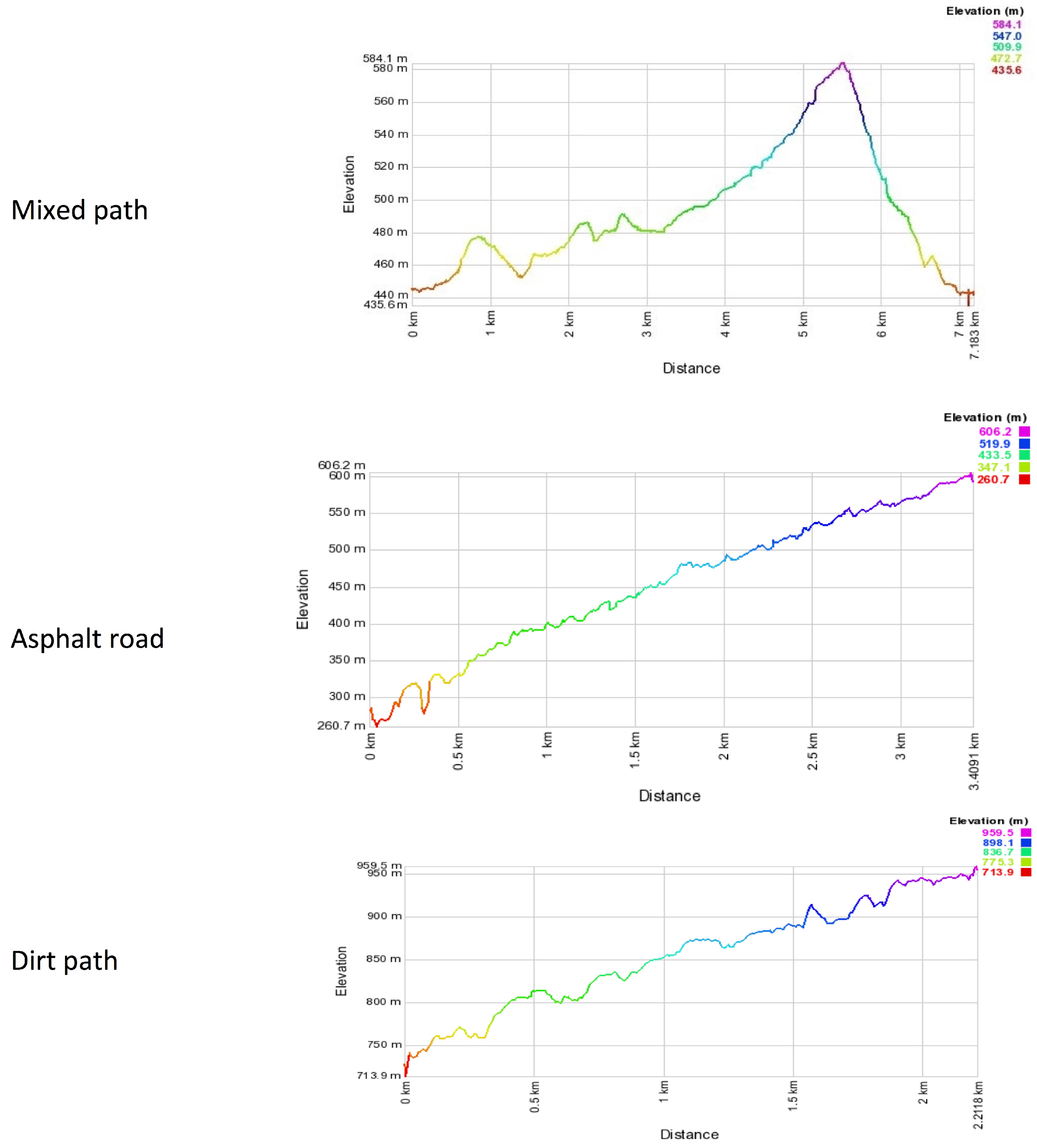
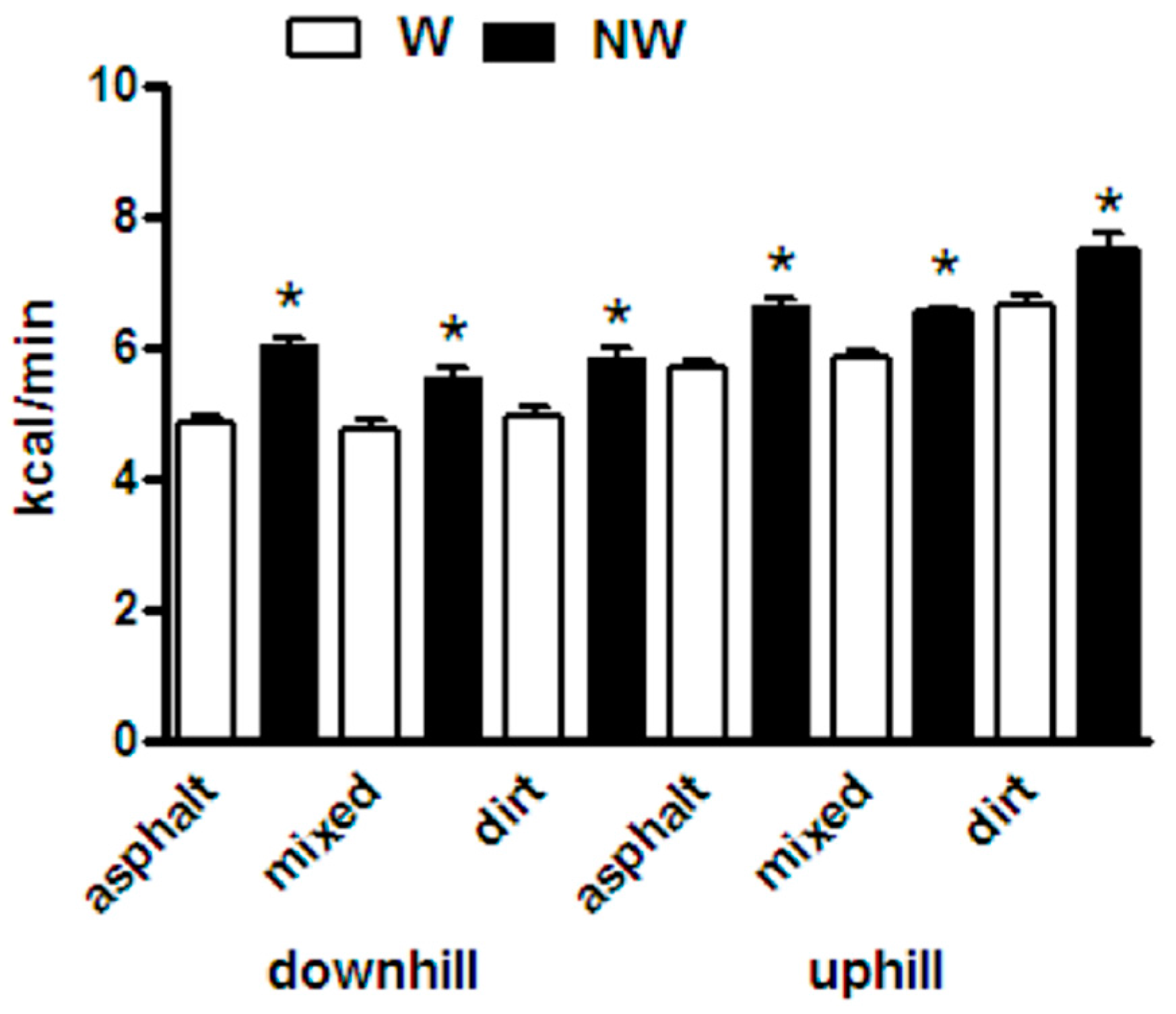
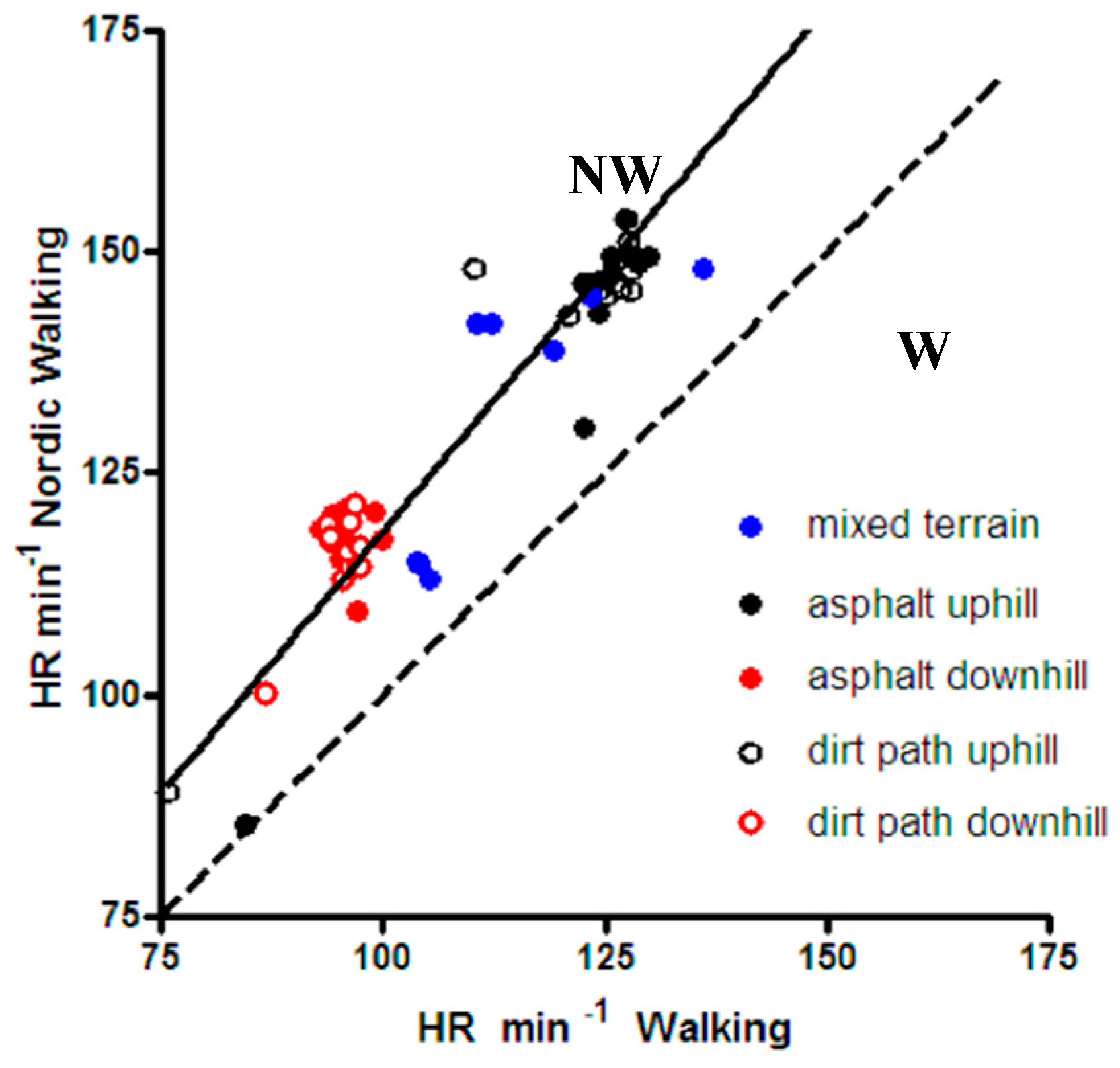
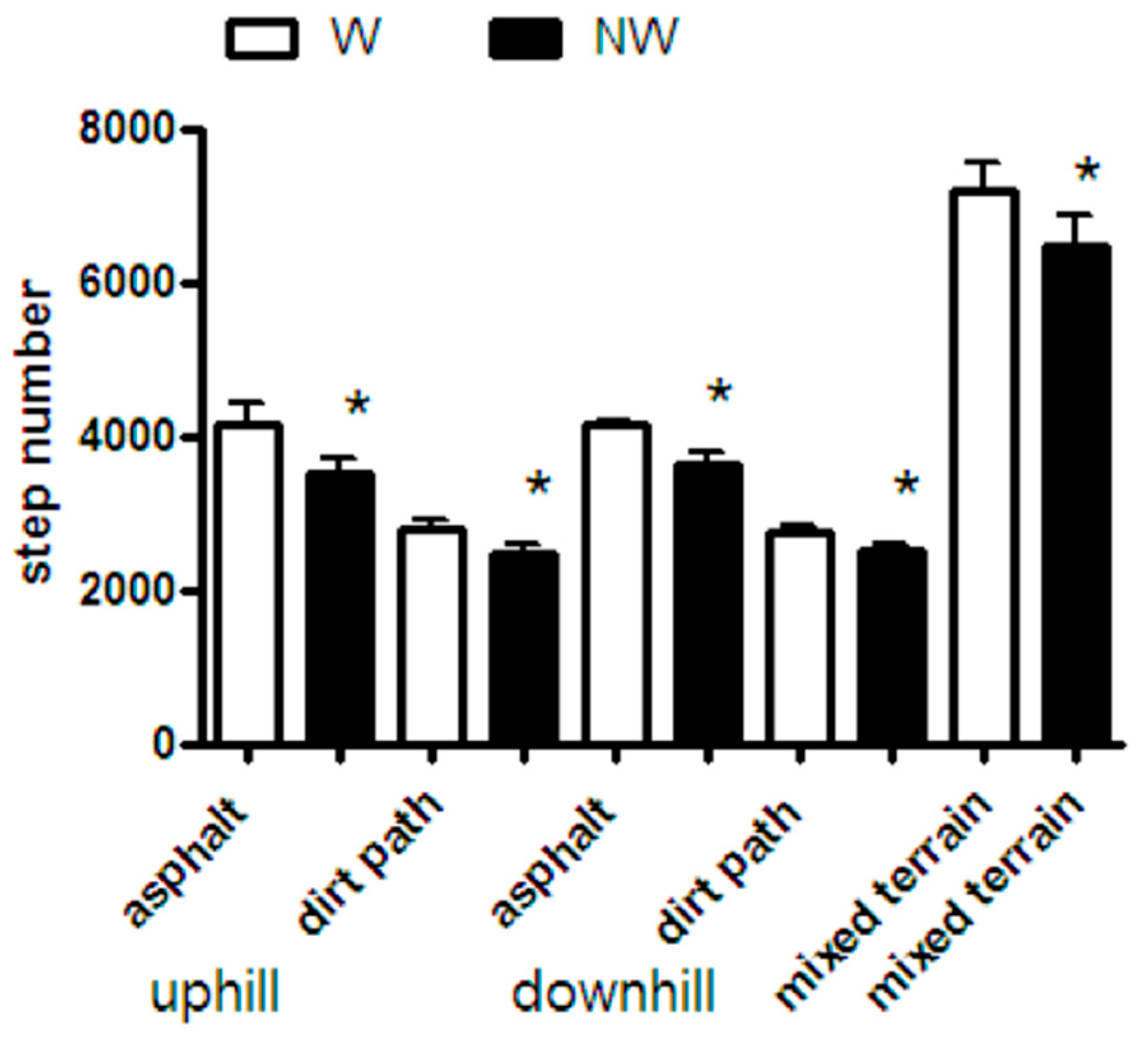
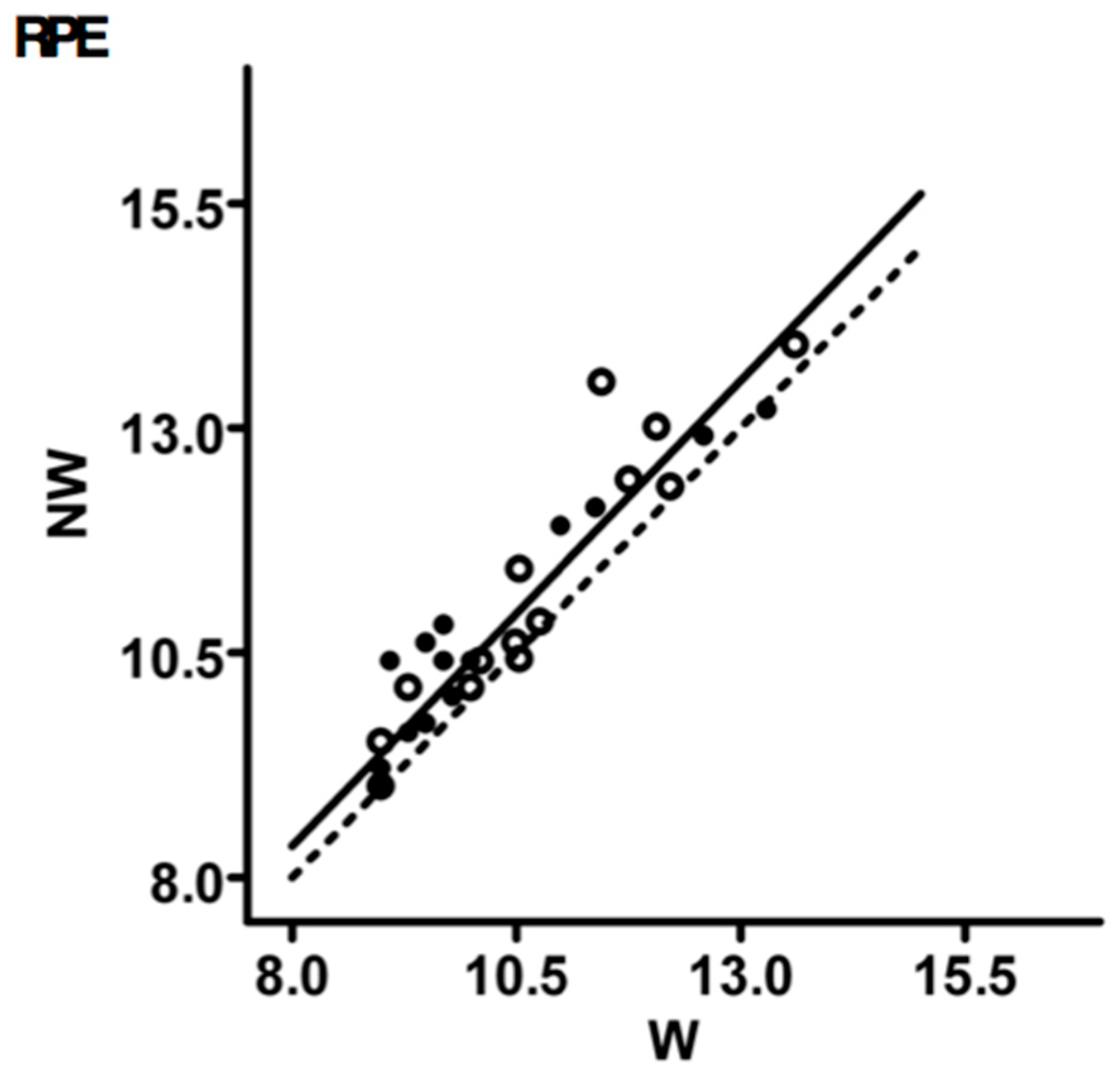
© 2017 by the authors. Licensee MDPI, Basel, Switzerland. This article is an open access article distributed under the terms and conditions of the Creative Commons Attribution (CC BY) license (http://creativecommons.org/licenses/by/4.0/).
Share and Cite
Grainer, A.; Zerbini, L.; Reggiani, C.; Marcolin, G.; Steele, J.; Pavei, G.; Paoli, A. Physiological and Perceptual Responses to Nordic Walking in a Natural Mountain Environment. Int. J. Environ. Res. Public Health 2017, 14, 1235. https://doi.org/10.3390/ijerph14101235
Grainer A, Zerbini L, Reggiani C, Marcolin G, Steele J, Pavei G, Paoli A. Physiological and Perceptual Responses to Nordic Walking in a Natural Mountain Environment. International Journal of Environmental Research and Public Health. 2017; 14(10):1235. https://doi.org/10.3390/ijerph14101235
Chicago/Turabian StyleGrainer, Alessandro, Livio Zerbini, Carlo Reggiani, Giuseppe Marcolin, James Steele, Gaspare Pavei, and Antonio Paoli. 2017. "Physiological and Perceptual Responses to Nordic Walking in a Natural Mountain Environment" International Journal of Environmental Research and Public Health 14, no. 10: 1235. https://doi.org/10.3390/ijerph14101235
APA StyleGrainer, A., Zerbini, L., Reggiani, C., Marcolin, G., Steele, J., Pavei, G., & Paoli, A. (2017). Physiological and Perceptual Responses to Nordic Walking in a Natural Mountain Environment. International Journal of Environmental Research and Public Health, 14(10), 1235. https://doi.org/10.3390/ijerph14101235







